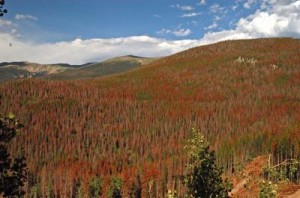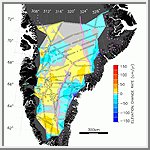Who knows, we may save fish tank scum as a biofuel.
Researchers have turned to algae as a promising new fuel source. The approach has the potential to significantly reduce the nation’s reliance on imported oil while contributing to rural economic development and lowering greenhouse emissions. As the nimrods of oil chant ‘drill baby drill’, the rest of the rational world may l be singing “suck baby suck” (or something to that effect).
Experts expect algae-based biofuels could displace large volumes of diesel and jet transportation fuels. One of the field’s leading experts, Ron Pate, a researcher from Sandia National Laboratories based in New Mexico, presented an overview of the research during the annual meeting of the American Association for the Advancement of Science in San Diego on Feb. 19.
Pate, who is a principal member of technical staff at Sandia, has been in Washington, D.C. since November 2009 serving as a technical consultant to the emerging algae biofuels program within the Biomass Office of the Department of Energy’s Office of Renewable Energy and Energy Efficiency (EERE).
The DOE program evolved out of an initiative started in 2008 to develop a National Algae Biofuels Technology Roadmap; researchers from Sandia, the National Renewable Energy Laboratory (NREL) and other national laboratories, universities and industry are teaming up with DOE to overcome some of the field’s biggest challenges.
“We’ve been heavily involved in supporting the Office of Biomass Program for the past year and a half on the Algae Biofuels Roadmap and a couple of specific projects that are algae biofuel-related,” Pate said.
Among those projects are two international collaborations: one with industrial partners in Israel and the U.S., and another with the National Research Council Canada.
“Using algae as a feedstock source for biofuels has a lot of potential benefits, but there are also some tremendous challenges. We’ve been working very hard to determine what the needs are, the current state of the technology and the areas that really need some focused investment and work,” Pate said.
Through recent American Reinvestment and Recovery Act (stimulus package) and other program investments in Integrated Biorefinery and Algae Consortia projects beginning in FY2010, DOE/EERE is providing about $180 million in near-term funding specifically focused on algae biofuels research and development.
Pate’s presentation, “The Promise and Challenges for Algae Biofuels: Overview of Approaches and Issues for Sustainable Production Scale-up,” will cover many of the current issues surrounding algae research and development. Algae is emerging as an attractive resource because it reproduces quickly, uses large quantities of carbon dioxide and can thrive in non-freshwater, including brackish and marine water, thus avoiding competition with traditional agriculture’s freshwater needs. In addition, algae can produce biomass and oils, and is attractive as feedstock for renewable fuels, with potentially greater productivity and significantly less land use requirements than with other commodity crop feedstocks such as corn, soy and canola.
Building on earlier work done under the DOE-funded Aquatic Species Program during the late-1970s through the early 1990s, Pate and others have been taking a new look at the nation’s potential for algae biofuels production capacity development and resource requirements. The U.S. has ample sunlight, lower value land and non-freshwater resources in the lower latitude coastal and inland states, including the Southwest region of New Mexico, Arizona and California, to potentially produce large volumes of biofuel feedstock, if high productivies can be reliably achieved.
With algal oil productivities that could potentially reach annual average levels in the range of 3,000 to 5,000 gallons per acre, the land footprint required for large volumes of renewable fuel production would be minimal when compared with other conventional oil crops, such as soy and canola, that produce between 50 and 120 gallons per acre per year.
“With algae, we’re talking about annual average productivities that could reach several thousand gallons per acre per year — with practical values that analysis has shown might be able to reach more than 6500 gallons per acre – so if you do the math, you can see the reasoning behind this research,” Pate said.
“Algae can produce oils, which are nature’s most effective energy storage medium. We already have the technologies coming online to be able to take that and affordably convert it into really useful fuels that are essentially drop-in equivalent to today’s petroleum-based ground and aviation transport fuels. And there is a lot of promise to create quite a bit of oil from algae, but nobody has really done that affordably on a large, routine scale yet so that you can rely on it day in and day out.”
Making the leap from the current preliminary analytical stage to full-scale muck production is challenged by a number of technical hurdles and unknowns. In the last decade, Pate and his colleagues have analyzed factors that are critical to the success of algal biofuels. Sunlight, carbon dioxide, usable, flat land and water are the key ingredients to algae growth, so the researchers looked for areas of the country where those factors were abundant and provided an optimal environment for growth.
The team determined that Southwestern states offer the most sun and large areas of available land, but are lacking in carbon dioxide and water. Although algae can thrive in the region’s brackish groundwater, uncertainties remain about how much water is actually available. The team also had to address concerns that biofuel production will encroach on the nation’s valuable land, water and fertilizer resources currently used for traditional agriculture.
To generate potential solutions, Pate and his colleagues contributed to a three-day workshop hosted by DOE’s Office of Biomass Program in December 2008 in Washington, D.C., to discuss the future of algal fuels research and industry. The event was attended by 200 technical experts and stakeholders from government and state agencies from around the nation, who provided valuable comments and insights.
Pate was part of the DOE-sponsored team that drafted a report based on comments received both at the workshop and from public, and the report, which will outline the nation’s strategy in algal biofuel research, is expected to be published in the next few months and will help drive the nation’s algal biofuels efforts.
Despite the challenges, Pate is confident that algae has a strong chance of becoming a viable source of transportation fuel in the long-term future. “People who are more realistic think this will take at least 10 years for research and investments to get it to the point where it has commercial viability,” Pate said. “I think the jury’s still out, but we’ll likely see an impact in the next decade.”



Little did Mr Hubris realize that his hubris jerked me into the conversation.
Actually, what I wanted to say was that unlike YOUR GOD, atoms and the speed of light do not lie. If you want to believe that YOUR deity has TOLD you that the Earth is only 6,000 years old, fine. Don’t use your faith to invalidate a physical mechanical fact. In other words, get the hell out of my face with your stupid comment! But I simplified.
To whit, a passersby added this gem: